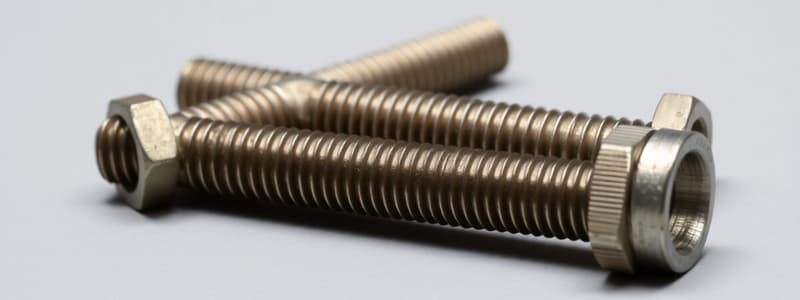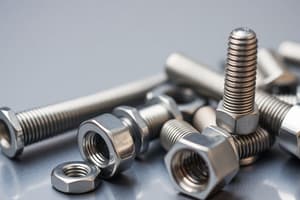Podcast
Questions and Answers
Which type of cotter pin cannot be used on a moving part?
Which type of cotter pin cannot be used on a moving part?
- Split ring cotter pin
- Self-locking cotter pin (correct)
- Metal cotter pin
- Nylon cotter pin
What is the main use of the AN970 washer?
What is the main use of the AN970 washer?
- Adjusting the position of castle nuts
- Applications on metal surfaces
- Applications in wood (correct)
- Providing a load-bearing surface
What is the primary function of safety devices such as lockwire and cotter pins?
What is the primary function of safety devices such as lockwire and cotter pins?
- To enhance aesthetic appeal
- To prevent unwanted assembly failure (correct)
- To reduce weight on fasteners
- To provide thermal insulation
Which of the following is NOT a type of lock wire mentioned?
Which of the following is NOT a type of lock wire mentioned?
What is the function of witness wire in control cables?
What is the function of witness wire in control cables?
What distinguishes NAS bolts from standard aircraft bolts?
What distinguishes NAS bolts from standard aircraft bolts?
Which statement about the markings on aircraft bolts is accurate?
Which statement about the markings on aircraft bolts is accurate?
What does a bolt's ' grip' refer to?
What does a bolt's ' grip' refer to?
What is one characteristic of close tolerance bolts?
What is one characteristic of close tolerance bolts?
How is the diameter of a bolt typically measured?
How is the diameter of a bolt typically measured?
Flashcards
Cotter Pins
Cotter Pins
Self-locking fasteners, commonly used in aircraft, that prevent parts from moving. They come in metal and nylon types.
Self-Locking Fasteners
Self-Locking Fasteners
Fasteners with built-in locking mechanisms that prevent parts from moving once assembled.
Washers (AN960)
Washers (AN960)
Thin, flat washers, commonly used for general aircraft applications.
Washers (AN970)
Washers (AN970)
Signup and view all the flashcards
Washer Purpose
Washer Purpose
Signup and view all the flashcards
Lockwire
Lockwire
Signup and view all the flashcards
Witness Wire
Witness Wire
Signup and view all the flashcards
Turnbuckles
Turnbuckles
Signup and view all the flashcards
Turnbuckle use in control cables
Turnbuckle use in control cables
Signup and view all the flashcards
Safety (in engineering)
Safety (in engineering)
Signup and view all the flashcards
Standard Aircraft Bolts (AN)
Standard Aircraft Bolts (AN)
Signup and view all the flashcards
NAS Bolts
NAS Bolts
Signup and view all the flashcards
Special Bolts
Special Bolts
Signup and view all the flashcards
Aircraft Bolt Markings
Aircraft Bolt Markings
Signup and view all the flashcards
Corrosion Resistant Bolt
Corrosion Resistant Bolt
Signup and view all the flashcards
Aluminum Bolt
Aluminum Bolt
Signup and view all the flashcards
Bolt Head
Bolt Head
Signup and view all the flashcards
Bolt Shank
Bolt Shank
Signup and view all the flashcards
Bolt Threads (UNC/UNF)
Bolt Threads (UNC/UNF)
Signup and view all the flashcards
Thread Gage
Thread Gage
Signup and view all the flashcards
Gen. Purpose Hex Head Bolt (GPB)
Gen. Purpose Hex Head Bolt (GPB)
Signup and view all the flashcards
AN Bolt Materials
AN Bolt Materials
Signup and view all the flashcards
Cad Plated Markings
Cad Plated Markings
Signup and view all the flashcards
AN Numbering System
AN Numbering System
Signup and view all the flashcards
Self-Locking Nuts
Self-Locking Nuts
Signup and view all the flashcards
Non-Self-Locking Nuts
Non-Self-Locking Nuts
Signup and view all the flashcards
Study Notes
Week 1 Tools - Bolts
- Bolt Materials: Standard aircraft bolts are most commonly made of steel, followed by corrosion-resistant steel, stainless steel, aluminum, and titanium.
- Standard Bolts (AN): Commonly used in general aviation.
- NAS Bolts: High tensile strength and close tolerance.
- Special Bolts: Used in applications requiring tighter fits, often marked with an (S) on the head.
- Aircraft Bolt Markings: Standard markings include X or *, corrosion-resistant bolts (-) and aluminum bolts (- -).
- Bolt Use Restrictions: Do not use aluminum bolts for tension applications—this is usually removed for maintenance.
- Bolt Head: Larger than the bolt's diameter, typically hexagonal, to aid in directional control during use.
- Bolt Grip/Shank: Threaded portion of the bolt, often referred to as the grip. The grip diameter matches the bolt diameter.
- Bolt Threads: UNC (coarse) and UNF (fine) threads are used; the thread gauge determines TPI (threads per inch).
AN Bolts (Air Force - Navy)
- General Purpose Hex Head Bolts (GPB): Used more broadly and identified by a 6-point hexagonal head.
- Bolt Dimensions: Specific dimensions including diameter and length.
- AN Bolt Material: Cadmium-plated Nickel Steel is a common material used; corrosion-resistant (C) and aluminum alloy (DD) materials are also used.
- AN Numbering System: Example: AN4-20A. The numbering system includes diameter, material, and length information; an 'A' or 'H' at the end signifies if there is a hole in the bolt head.
Week 2 (Nuts & Bolts)
- Nuts & Bolts Classification: Divided into self-locking and non-self-locking types.
- Non Self-Locking: Requires an external locking device (e.g., cotter pins).
- Self-Locking: Integrated locking mechanism, commonly utilized in aircraft applications.
- Self Locking Types: Two primary types: metal and nylon.
- Washers: Used in many applications, mainly to protect and ensure proper contact. The most common types are AN960 and AN970.
Week 3 (Safety)
- Safety Features: Prevent failure of secured devices, providing backup and security during events such as fire suppression.
- Lockwiring: An example of a safety feature to prevent unwanted assembly.
- Types of Lock Wire: Stainless steel, Inconel, and Monel are types of lock wire to know.
- Standard Wire Diameters: 0.020”, 0.032”, 0.041” are common diameters.
- Turnbuckles: Purpose is to adjust cable tension; used in control cables on aircraft.
- Witness Wire: Designed for visible confirmation of securement during inspections to prevent damage and misuse of other equipment.
- Witness Wire Application: DO NOT use lock wire when deploying witness wire.
Additional Notes
- Witness wire is used to ensure that the cover remains in place, such as during a fire suppression.
- Minimal breaking force is ideal for witness wire to prevent damage to equipment.
Studying That Suits You
Use AI to generate personalized quizzes and flashcards to suit your learning preferences.



